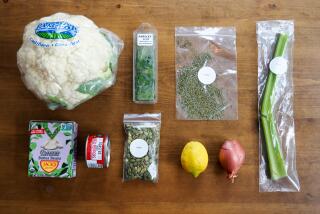Handling Food the Healthful Way
- Share via
Here are some tips from federal health officials on preparing foods properly:
* Wash hands with soap and hot water before preparing food.
* Wash the lids of canned foods before opening to keep dirt from getting into the contents. Clean the blade of the can opener after each use.
* Wash fruits and vegetables and, if necessary, scrub them with a brush.
* One of the most problematic foods in recent years has been ground beef, linked to infections caused by E. coli. The Centers for Disease Control recommends that the internal temperature of ground meat patties reach 155 degrees for at least 15 seconds. The meat should be cooked until it is gray or brown throughout and the juices clear.
* Marinate meat, poultry and seafood in the refrigerator, not at room temperature. After marinating, dispose of the sauce because it contains raw meat or fish juices. Fresh marinade used for basting as meat cooks should not be applied during the final stages of cooking or grilling. To use marinade as sauce, double the recipe and set half aside in the refrigerator, away from meat; use uncontaminated portion as sauce after meat is cooked.
* Don’t reuse any container or bowl that has held raw protein foods until it has been thoroughly cleaned.
* Wash kitchen towels and aprons frequently.
* Change sponges often.
* Sterilize cutting boards by washing in soap and hot water, then rinsing with a diluted bleach mixture after each use, or wash in dishwasher using highest heat setting.
* Do not reuse cutting boards after they come in contact with raw protein foods without washing them in hot water and soap. The same rule applies to utensils, knives and counter surfaces.
* Food processors, meat grinders and blenders should be taken apart and cleaned as soon as possible after use.
* Serve hot foods hot, above 140 degrees. Use meat thermometer to determine doneness.
* Leftovers should be brought to 165 degrees before serving.
* Serve cold foods below 40 degrees.
* When dealing with large quantities of leftovers, split the dish into several small, shallow storage containers so that the contents cool down rapidly. Do not simply remove a large pot of food (such as soup, stew, pasta sauce) from the stove and place it in the refrigerator. Such a large mass of food will take hours or days to properly chill and will provide an ideal environment for the growth of harmful bacteria.
* Do not allow cooked foods to sit at room temperature for more than two hours. Refrigerate leftovers immediately after the meal.
* Use or freeze leftovers within two days.
Source: U.S. Department of Agriculture
More to Read
Eat your way across L.A.
Get our weekly Tasting Notes newsletter for reviews, news and more.
You may occasionally receive promotional content from the Los Angeles Times.










